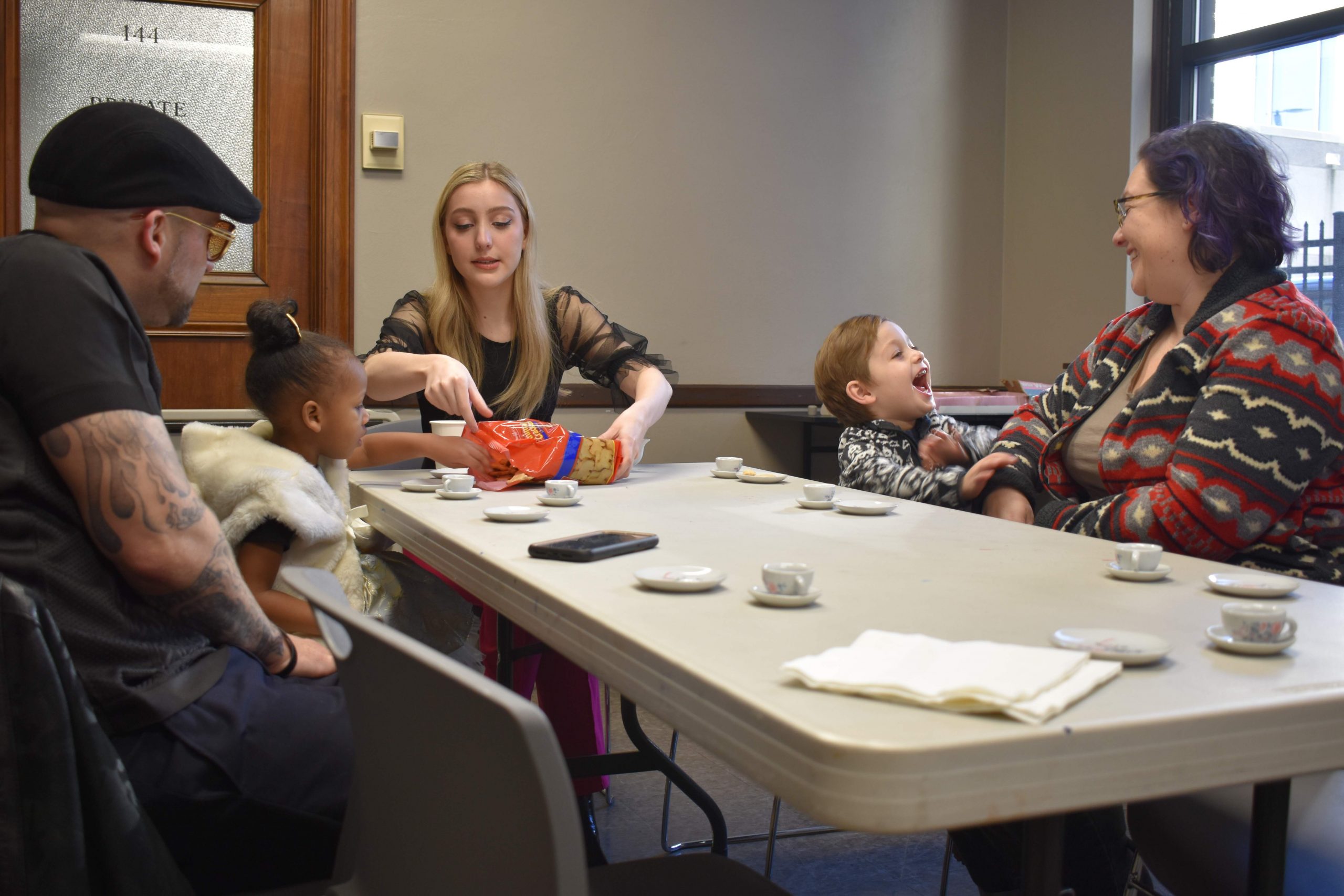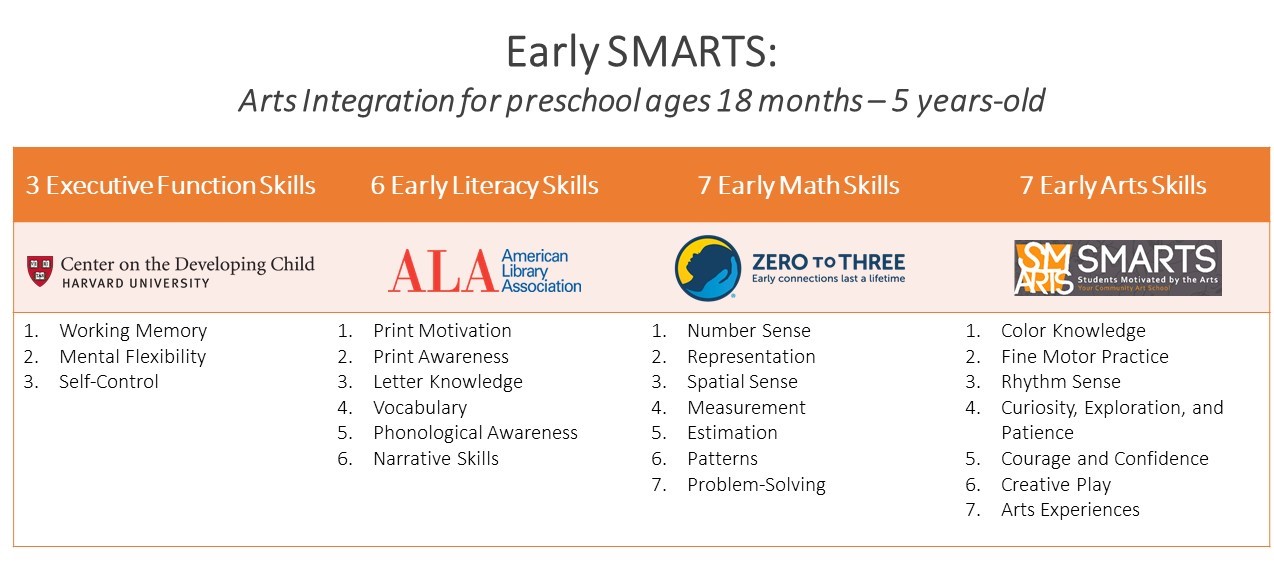Early SMARTS
Early SMARTS classes are an introduction to the arts for children ages 18 months - 5 years old. Through creative play and exploration, our goal is to help our little creatives develop critical thinking, problem-solving, and a strong sense of imagination. Learning is accomplished by experiencing. Children have unlimited ways to express themselves and are learning constantly. We simply want to teach students to use painting, sculpting, dancing, and acting as other tools, thus we utilize Reggio Emilia’s Philosophies. We believe the physical environment, other students, and self-exploration are also teachers.
Early learning in the arts helps students develop the three Executive Function Skills set forth by the Harvard Center for Early Development by exhibiting self-control, activating sensory stimuli, and memorizing roles and patterns. Beyond age 5, research has shown that pursuing any arts discipline - visual art, music, dance, theater, or creative writing - will bolster students’ overall intelligence, sense of well-being, and empathy for others.
SMARTS use arts-integrated approaches to reinforce and teach literacy and math skills. Additionally, SMARTS classes cover multiple Ohio Early Learning Development Standards (Approaches to Learning, Cognitive Development, Creative Development, Language and Literacy, Mathematics, Physical Development and Wellness, Science, Social and Emotional Development, and Social Studies). We “teach the whole child” and nurture the creative voice inside all children.
Early SMARTS is one of SMARTS Premier Programs and classes occur both in the community and at SMARTS in the Ohio One Building.

Early SMARTS classes are created to deepen or develop the 7 following skills:
What does Early SMARTS look like?
What to Expect for Public Early SMARTS classes that occur @ SMARTS in the Ohio One Building
The Early SMARTS teacher will provide rules and expectations for safety and behavior, but it is understood that students may engage with the activities in various ways depending on their ability level. The Parent/Guardian role is to help support their child by encouraging them to make their own creative choices. We encourage Parents/Guardians to take the class time as an opportunity to learn best practices for early arts learning and to play along with their child so as the teacher, you are teaching the adult and the student. Encourage them to step out of their comfort zone, or model creativity for your student/s by doing something unexpected. Our goal includes “Green Skies, Blue Trees” Creativity and coloring out of the lines is expected and encouraged, along with the Reggio Emilia approach in which children are active protagonists in their growing processes.
What to Expect for Community Early SMARTS classes at our partner locations
The Early SMARTS teacher will follow the rules and standards set forth by the partner school district and all classroom rules will fall under the district code of conduct. Early SMARTS teachers can expect classroom teachers and/or aides to stay with students. Teachers are encouraged to engage the teachers and aides, in addition to the students, as key players in the instruction and arts exploration. We encourage all adults present in the classroom to support and encourage students to make their own creative choices and use class time as an opportunity to learn best practices for early arts learning. Our goal includes “Green Skies, Blue Trees” Creativity and coloring out of the lines is expected and encouraged, along with the Reggio Emilia approach in which children are active protagonists in their growing processes.

Example Early SMARTS Lessons
Visual Art
Early SMARTS Body Shape Painting
This class takes finger painting to a whole new level. Students learn to play with paint by using parts of their bodies to create class murals. Using large rolls of paper and canvas tarp, students will create paintings based on a story read in class. Students might stomp with paint on their feet or roll across the tarp to paint with their whole body. What shapes can you paint with your elbows and knees? This class will be messy and a truly creative hands-on approach to making art. Students should come to class in old clothes. Plastic coverings and a cleaning station will be provided for students.
Music
Early SMARTS Pots and Pans
Cook up a musical masterpiece and experiment with our brand-new steelpans. We will cook up silly songs, creative beats, and random rhymes. Wooden spoons, drum mallets, and chopsticks are welcome here. Come join the neighborhood band!
Dance
Early SMARTS Animal Dance
Students learn to dance by mimicking the movement of animals, reading stories about animals from around the world, and imagine the kind of music animals might like to dance to. The animals will help us learn our right from our left, how to count, and give us a tour of the science behind the natural world and animal life.
Theater
Early SMARTS Neighborhood Theater
Using a prop box with objects and costumes, students will role-play to learn about different types of people in their neighborhood and what their jobs are. Students will read a story each class to help them understand the problem that has occurred today in the town, and through creative play, students will interact with each other in character to solve the problem.
Creative Writing
Early SMARTS Artist 101: Out of the Box
Based on the book, “A Box Can Be Many Things,” students will explore all five SMARTS disciplines – visual art, music, dance, theater, and creative writing – using ONLY boxes. Discover all that a box can be, learn what it means to be an artist, what makes something art, and stretch your imagination to think outside the box.
Partner with SMARTS!
Contact SMARTS President Becky Keck, bkeck@SmartsArtSchool.org, to inquire about professional developments for teachers, Artists-in-Residence, or having a SMARTS teaching artist at your school all year with SMARTS programming.
About Us
SMARTS, Students Motivated by the Arts, is a community art school that provides classes in visual arts, music, dance, theater, and creative writing for our region's PK-12 youth with a focus on underserved populations.
Address: 25 East Boardman Street, First Floor, Youngstown, Ohio 44503
Phone: 330-574-2787
Email: info@SmartsArtSchool.org
Our Services
SMARTS hires and prepares community teaching artists with professional training and oversight so that they can provide quality arts-focused teaching and learning with lesson plans that follow state standards. Since 1997, SMARTS classes have been free and open to the public and all students are accepted through a simple application process.





